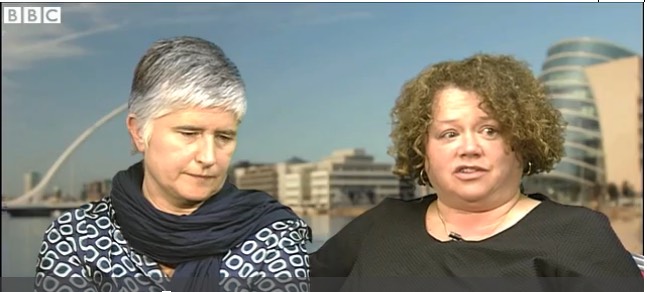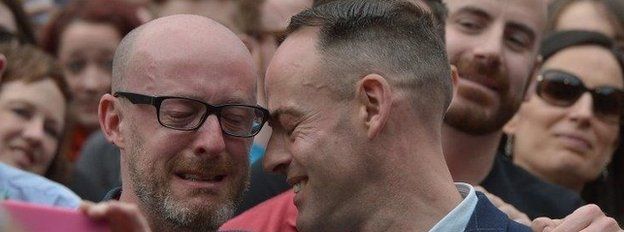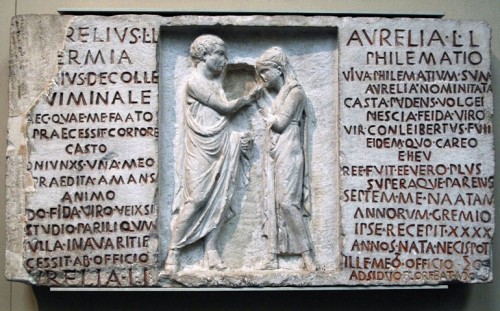How the Pope Might Renew the Church
I AM a Catholic, born in 1921 of Italian and Irish families and raised in California seminaries. After decades of work as a priest, I was astonished that Pope Paul VI appointed me a bishop in San Francisco. I love my church, and every night I pray that I might die in her warm, loving arms.

Yet I worry about my church’s future. Basic doctrines will not change. But the church may change policies and practices after doing serious study.
So, as we await Pope Francis’ visit to America, I offer a peaceful contribution to the controversies that convulse the church today.
American Catholics are divided, primarily, by three internal church conflicts.
The first is over priestly celibacy. Observers within and outside the church point to mandatory celibacy as a principal factor driving down the number of American priests.
A celibate life is admirable for a priest who personally chooses it. For 1,000 years, great good has been accomplished because priests could fully devote their lives to their ministry.
Nevertheless, in recent years married clergy of other Christian churches have been accepted into service in the Catholic Church. So far, the ministry of these married priests has appeared successful.
The church should start relieving the desperate shortage of clergy members by also accepting for ordination men of mature age, of proven character and in stable marriages.
Optional celibacy allows a choice between an abstinent life, totally free for ministry, or a married life that enables better understanding of the lives of parishioners.
American Catholics are also divided over the ordination of women as priests.
Recent popes have said publicly that priesthood for women cannot be considered because the gospel and other documents state that Christ ordained men only.
Yet women have shown great qualities of leadership: strength, intelligence, prayerfulness, wisdom, practicality, sensitivity and knowledge of theology and sacred Scripture.
Might the teaching church one day, taking account of changing circumstances, be inspired by the Holy Spirit to study and reinterpret this biblical tradition?
Finally, why is a divorced Catholic who has remarried denied the Eucharist? Such people are considered living in an irregular union.
Valid marriages remain indissoluble. However, in confession a priest, after reviewing the circumstances with a remarried penitent, already can assist that person to develop a clear conscience with God and resume receiving the Eucharist.
Last month, Pope Francis stated that divorced and remarried Catholics were “not excommunicated,” perhaps suggesting that prohibition of the Eucharist is under review.
In surveys today, the question “to what church do you belong?” increasingly prompts the answer “none.” Polls show that many high school and college students have gradually come to believe that what they learned as children about the nature of God can be erased as readily as Santa Claus and the tooth fairy.
The culture that surrounds them focuses on science, growing out of the long history of Copernicus, Darwin, Freud, Einstein and Hawking. Still, most young people become not atheistic but agnostic, still searching even as they entertain doubts about God.
Pope Francis prefers the simple title “bishop of Rome.” So I ask my brother bishop: Should we not convene a third Vatican Council just as ethical and paradigm-shifting as Vatican Council II of the 1960s?
A Vatican Council III would bring together the world’s bishops under the unifying guidance of Peter. It would include representative major theologians, scholars of sacred Scripture, scientists and appropriate academics, lay people of all ages, clergy members and parishioners, and officials of other faiths.
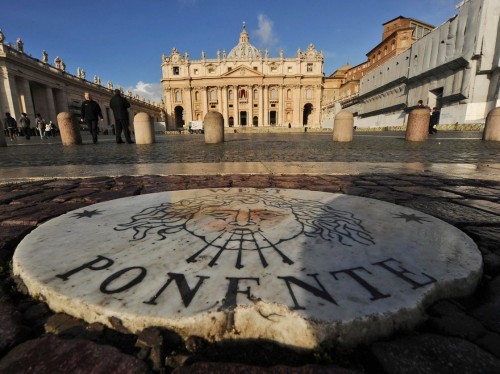 In addition to the three issues dividing the church, this council and future councils would explore the morality of world economies, spiritual life, human sexuality, peace and war, and the poor and suffering.
In addition to the three issues dividing the church, this council and future councils would explore the morality of world economies, spiritual life, human sexuality, peace and war, and the poor and suffering.
Such a council might slow or reverse the flow of the faithful out of the church. It would also stimulate a new conversation about God, one that shows young people that God is not an old man with a long white beard. God is infinite and unlimited.
This is not easy to grasp. God is incomprehensible to our finite minds. We surmise that God is spirit, straddling the universe and parallel universes. At the same time God is intimate to each of us. We cannot prove existence by reason, nor can science disprove God’s existence.
Moreover, faith and science are not in conflict.
Many of the young say they relate to God personally and do not need a church. We applaud this personal relationship, but it is also truly human to do things in community: We party together, we play sports together, we enjoy meals together. The three generations of my own nieces and nephews are just as moral as I am, if not more so. Could it be that they know more clearly what Pope Francis has been asking of us for the past two years — to be more loving and accepting?
What caused much of the church over the centuries to underestimate the gospel’s core message, which is love? After the emperors Constantine and Theodosius embraced Christianity in the fourth century, one strain in the church developed a spirit of power and dominance, seen most clearly in the Crusades and the Inquisition. Many, including Pope Gregory VII, tried heroically, but unsuccessfully, to stop this trend.
Therefore, the main challenge facing the church today is not simply to resolve questions like celibacy, but to relearn how to communicate a deeper, more intelligent, more relevant religion that leads to a life of acceptance and love.
Complete Article HERE!
Vast majority of U.S. Catholics who left the church can’t imagine returning, study says

Most Americans who were raised Catholic but have since left the church could not envision themselves returning to it, according to a new Pew Research Center survey examining American Catholics and family life. The survey’s findings were released Wednesday, weeks before Pope Francis makes his first visit to the United States, and as Catholic leadership contends with dramatic demographic shifts.
 Seventy-seven percent of those who were raised Catholic but no longer identify with the religion said they could not envision themselves eventually returning to the church, according to the Pew survey. The survey also examined U.S. Catholics’ views on issues such as divorce, same-sex marriage and sinful behavior, finding an openness for non-traditional family structures.
Seventy-seven percent of those who were raised Catholic but no longer identify with the religion said they could not envision themselves eventually returning to the church, according to the Pew survey. The survey also examined U.S. Catholics’ views on issues such as divorce, same-sex marriage and sinful behavior, finding an openness for non-traditional family structures.
Although Catholics have long made up about a quarter of the U.S. population, recent data has shown that percentage dropping. In 2007, 23.9 percent of Americans identified as Catholic. In 2014, 20.8 percent of Americans said the same, according to previous survey results from Pew.
But the new survey illustrates something else about Catholic life in the United States: while the percentage of Americans who may identify their religion as Catholicism is dropping, a much larger group of Americans identify as Catholic in some way.
In all, 45 percent of Americans say they are either Catholic, or are connected to Catholicism. That larger percentage includes “Cultural Catholics” (making up nine percent of those surveyed) who are not practicing Catholics but who identify with the religion in some way; and “ex-Catholics” (also nine percent) who were formerly Catholic but no longer identify with Catholicism at all. And another eight percent said they had some other connection to Catholicism, for instance by having a Catholic partner or spouse. For the purposes of the survey, Pew kept each category mutually exclusive.
According to the survey, about half of those who were raised Catholic end up leaving at some point, while about 11 percent of those who left have since returned.
The breakdown provides an interesting look at the cultural reach of Catholicism, beyond those who would call themselves members of the religion. For instance, the survey also found that eight in ten American Latinos have some direct connection to Catholicism, whether as a current practicing Catholic, as an ex-Catholic, or otherwise.

The study also sheds some light on how Catholic American attitudes on family, sex, and marriage compare with church teaching. When asked whether they believed the church should change its position on a variety of issues, a very large percentage of religiously identified Catholics — 76 percent — expressed a desire to see the church allow the use of birth control. Sixty-two percent felt that the church should allow priests to marry, and about the same percentage thought that the church should allow divorced and cohabitation couples to receive communion.
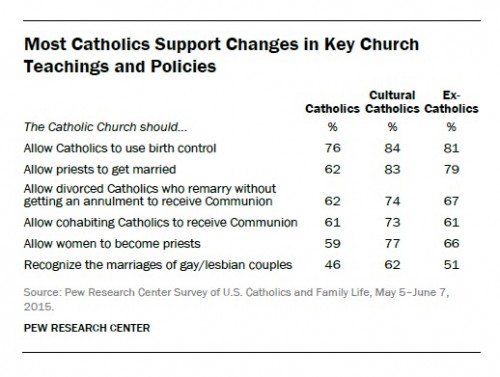 Fifty-nine percent of Catholics surveyed thought women should be allowed to become priests. Meanwhile, just 46 percent of Catholics believe the church should recognize the marriages of gay and lesbian couples.
Fifty-nine percent of Catholics surveyed thought women should be allowed to become priests. Meanwhile, just 46 percent of Catholics believe the church should recognize the marriages of gay and lesbian couples.
Among those Catholics who attend Mass weekly, support for these changes was lower overall. But Pew notes that even among this particular population, two-thirds of Mass-going Catholics think the church should relax its prohibition on contraceptives.
Overall, cultural Catholics were more supportive of the changes named by the survey, while ex-Catholics were more supportive of allowing priests to marry, and for women to become priests.
Although an overwhelming majority of Catholics (nine in ten) believe in the concept of sin, they don’t seem to agree on what, precisely, constitutes one. Fifty-seven percent of Catholics think it’s a sin to have an abortion, compared to 48 percent of the general U.S. population who say the same. Forty-four percent think homosexual behavior is sinful (about the same say this among the general public). And just 17 percent of Catholics believe its a sin to use contraceptives, while 21 percent say the same of getting a divorce.
And although those percentages are higher for those who attend Mass weekly — 73 percent of weekly churchgoers say that abortion is a sin, for instance — the numbers are still pretty low on the issue of contraception: just 31 percent of weekly Mass attendees say the use of artificial contraception is a sin.
Despite those disagreements between U.S. Catholics and church teaching, the poll does not indicate that a change in that teaching would lead more Catholics to “revert” to their faith than do already.
Cultural and ex- Catholics gave a variety of answers when asked why they decided to leave Catholicism, and no consensus emerges from those reasons that could point to any one factor driving away those who were raised Catholic from the faith. A 2008 Pew study asked a similar question, and found that fewer than one in four Catholics said that the rule banning priests from marrying was an important reason for leaving Catholicism. About 3 in 10 said that the church’s teachings on abortion and remarriage were important.
Far more common, in that 2008 survey, were those who said they simply stopped believing the church’s overall teachings, or gradually drifted away from Catholicism, or said that their spiritual needs weren’t being met.
The latest survey finds clearer answers for why “cultural Catholics” identify with the religion in some non-religious way – 59 percent of those who were raised Catholic or have a Catholic parent cite this familial connection as the reason they are tied to the church. Cultural Catholics without a parental connection cite a variety of reasons, including having a Catholic spouse (15 percent), a general affiliation with Christian beliefs or practices (nine percent) or the idea that their religion is rooted in Catholicism (15 percent).
The 2015 Pew survey was conducted between May 5 and June 7 among a national sample of 5,122 adults reached on conventional cellular phones, including 1,016 Catholics. The margin of sampling error for results among Catholics is plus or minus 3.5 percentage points; the error margin is 5.5 points among the sample of 425 “Cultural Catholics” and among the sample of 413 “Ex-Catholics.”
Complete Article HERE!
A Catholic University Wishes Professor “Many Blessings” After He Marries His Same-Sex Partner
“Same-sex unions are now the law of the land, and Professor Hornbeck has the same constitutional right to marriage as all Americans,” said a statement from New York’s Fordham University after the marriage of its theology department chairman.

A Catholic university in New York City has said it will take no action against the chair of its theology department after he married his same-sex partner on June 27, in contrast to the several parochial K-12 schools that have fired gay and lesbian employees who marry.
The marriage of Fordham University Theology Professor J. Patrick Hornbeck and Patrick Bergquist — who directs the family ministry of St. Bartholomew’s Episcopal Church in Manhattan — was announced in the “Weddings” section of the New York Times the day after their ceremony.
In response to an inquiry from BuzzFeed News, Fordham University provided a statement from Senior Director of Communications Bob Howe saying that university wished the best for Hornbeck and his husband.
“While Catholic teachings do not support same-sex marriage, we wish Professor Hornbeck and his spouse a rich life filled with many blessings on the occasion of their wedding in the Episcopal Church. Professor Hornbeck is a member of the Fordham community, and like all University employees, students and alumni, is entitled to human dignity without regard to race, creed, gender, and sexual orientation,” Howe said in a statement that had been released previously. “Finally, same-sex unions are now the law of the land, and Professor Hornbeck has the same constitutional right to marriage as all Americans.”
Fordham’s response to Hornbeck’s marriage has been attacked in a number of conservative Catholic websites over the past two weeks, apparently beginning with Patheos.
Fordham University describes itself as “both Catholic and Jesuit” in identity, and invokes Catholic doctrine in other areas, including prohibiting the distribution of birth control.
“As an institution in the Catholic, Jesuit tradition, Fordham University follows Church teachings on reproductive issues,” states the university’s student handbook. “Distribution of contraceptives, contraceptive devices and/or birth control, in any form, is prohibited on Fordham University property and at University-sponsored events.”
The New York Archdiocese did not immediately respond to a request for comment on Fordham’s response to Hornbeck’s marriage. Neither Hornbeck nor his husband could be reached for comment.
Hornbeck’s marriage follows controversies in several archdiocese around the country where gay and lesbian teachers at Catholic K-12 schools have been fired after marrying their same-sex partners. The most recent firing to make national news was at the Waldron Mercy Academy just outside Philadelphia, where the archdiocese will host a large family summit in September that is schedule to include a visit by Pope Francis.
The Academy notified parents at the end of the school year that it was not renewing the contract of its longtime director of religious education, Margie Winters, because of her marriage to Andrea Vettori. Vettori appealed directly to the pope to intercede in a letter made public on July 1.
Philadelphia Archbishop Charles Chaput praised Winters’s firing as showing “character and common sense at a moment when both seem to be uncommon.”
Complete Article HERE!
Church in Ireland needs ‘reality check’ after gay marriage vote
One of Ireland’s most senior Catholic clerics has called for the Church to take a “reality check” following the country’s overwhelming vote in favour of same-sex marriage.
The first gay marriages are now likely to take place in the early autumn.
Diarmuid Martin, the archbishop of Dublin, said the Church in Ireland needed to reconnect with young people.
The referendum found 62% were in favour of changing the constitution to allow gay and lesbian couples to marry.
The archbishop told the broadcaster RTE: “We [the Church] have to stop and have a reality check, not move into denial of the realities.
“We won’t begin again with a sense of renewal, with a sense of denial.
‘Message’
“I appreciate how gay and lesbian men and women feel on this day. That they feel this is something that is enriching the way they live. I think it is a social revolution.”
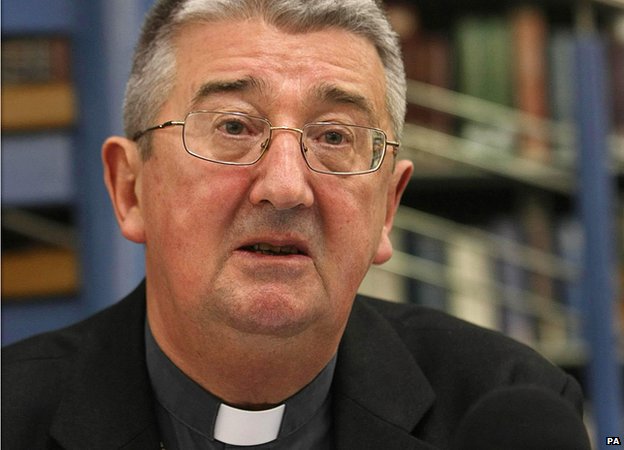
The archbishop personally voted “No” arguing that gay rights should be respected “without changing the definition of marriage”.
“I ask myself, most of these young people who voted yes are products of our Catholic school system for 12 years. I’m saying there’s a big challenge there to see how we get across the message of the Church,” he added.
Ireland is the first country in the world to legalise same-sex marriage through a popular vote, and its referendum was held 22 years after homosexual acts were decriminalised in the Republic of Ireland.
Among those voicing their approval of the outcome was UK Prime Minister David Cameron who tweeted: “Congratulations to the people of Ireland, after voting for same-sex marriage, making clear you are equal if you are straight or gay.”
Analysis
By BBC’s Ireland correspondent Chris Buckler
In Ireland debates about morality tend to be rooted in religion. The discussion about same sex marriage was no exception.
The Catholic Church after all still has much influence in Ireland and the no vote was strongest in rural areas where church attendance figures tend to be higher. That sharply compared to the cities where the yes campaign never doubted their support.
There was also a generational divide – with the yes campaign capturing the interest and enthusiasm of young people in a way that few elections do. Some living abroad even returned home to Ireland simply to visit the ballot box.
The Catholic Church is not immune from the influence of an increasingly liberal Ireland.
In his appeal for a no vote the church’s most senior figure In Ireland specifically recognised the love shared between same sex couples.
That is a softening of language and in its own way a sign of wider change.
In total, 1,201,607 people voted in favour of same-sex marriage, while 734,300 voted against.
Out of 43 constituencies, only the largely rural Roscommon-South Leitrim had a majority of “no” votes.
The yes vote means an amendment will be made to Article 41 of the constitution, stating that being of the same sex is no longer an impediment to marriage.
The government must bring in a new law, the Marriage Bill 2015, to give effect to the amendment and it says it hopes to do that by the time the Irish parliament breaks up in the summer.
This means the first actual marriages are unlikely to take place until September.
Same-sex marriage is now legal in 20 countries worldwide.
What the ‘yes’ vote means
The Republic of Ireland has a written constitution which can only be changed by referendum.
Now that the proposal has been passed, a marriage between two people of the same sex will have the same status under the Irish constitution as a marriage between a man and a woman.
They will be recognised as a family and be entitled to the constitutional protection for families.
Civil partnerships for same-sex couples have been legal in Ireland since 2010, giving couples legal protection which could be changed by the government.
However, married gay people will now have a constitutional standing that can only be removed by another popular vote.
According to the Irish Times, there will be no new civil partnerships from the day the law comes into effect, and although civil partners will retain their existing rights, there will be no automatic upgrade from partnership to marriage.
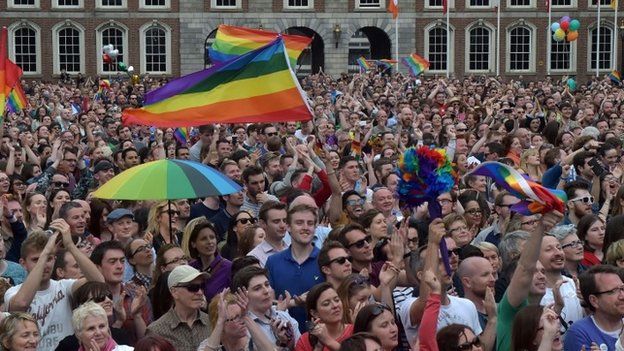
Complete Article HERE!
Tears and celebrations likely to follow as Ireland says Yes
Young were given something they could believe in – campaign for and vote for

By Fiach Kelly
The counting is continuing, but the smiles of all those who voted Yes are widening.
The chests of Yes campaigners are being pushed out; the tears and celebrations are likely to follow when confirmation of the results are announced in Dublin Castle.
Not only has Ireland has agreed to same-sex marriage, it has done so in a louder voice than many could have imagined, carried on the back of a remarkable turnout and an engagement by younger people not seen in years.
Following years of the politics of recession and bailout, the young were given something they could believe in, campaign for and vote for. And they did.
For campaigners, the main task was to tap into this latent goodwill and desire to make a societal change a generation could claim as its own.
The campaign became about more than just same-sex marriage. It became a debate about the place of the gay community in Irish society and the country’s acceptance of it.
Yes Equality, the umbrella organisation comprised of a number of groups, deserves enormous credit for the drive and organisational skill it has shown in recent weeks.
That’s not to say it was all plain sailing. There were wobbles. One came around the Easter period when many in politics felt the Yes campaign was talking to itself, although this was swiftly rectified with a focus on personal stories and the experiences of gay people and their families.
The term “national conversation” is one of the most horrible phrases to enter public debate in recent years, but the campaign offered something along those lines. Many gay people felt comfortable to speak about themselves and who they are, winning the arguments in their families and communities.
A second wobble came two weeks ago as the No side gained traction with issues such as surrogacy and adoption, and the absence of opinion polls, coupled with fears of a shy No vote, increased nerves.
Again this was rectified by personal stories, the most powerful of which was from journalist Ursula Halligan, and interventions by people such as Daniel O’Donnell.
Yes campaigners took heart and many in the political and media bubble predicting doom were out of step with the country. Canvass returns from the last month told the Yes side they would win, and win well.
The campaign was not party political, but the parties can take credit today. Labour championed same-sex marriage from the outset of the Government’s term, and before. Eamon Gilmore’s role in pushing it on to the agenda must be also be acknowledged.
After initial reticence, the Taoiseach took on a leading role in the campaign and Fine Gael pushed as if the issue were its own. Maybe it sensed an avenue to broaden the party’s appeal to different sections of the electorate but many in the party believed deeply in it, even if the enthusiasm wasn’t shared by some of its conservative members.
Credit too must go to Fianna Fáil leader Michéal Martin and Sinn Féin, both of whom could have opposed the referendum for narrow political gain but chose not to. Mr Martin in particular had to deal with the fact that not only were many of his rank and file members against the proposal, some of his TDs opposed it too.
Yet, this one was largely for the younger generation, which turned out in its droves. Stories of emigrants returning home to vote and huge increases in voter registration offered indications of what was to come but the final results were astonishing.
Campaigners said those on the supplementary register were overwhelmingly young, and the turnout showed they proved the old adage that they don’t vote wrong.
All across the country, the turnout on the supplementary register hovered around 90 per cent, even reaching 99 per cent in Huntstown, west Dublin, by close of polls.
Such enthusiasm can be infectious and perhaps convinced older, sceptical voters not to stand in the way of something younger generations believed in.
Complete Article HERE!
Priests Defy Bishops To Support Marriage Equality In Ireland
There is a battle going on within the Irish Catholic Church at the moment.
Father Martin Dolan faced a difficult decision. With Ireland’s referendum on marriage equality looming, he could either go along with his bishops’ official opposition to it, or he could be honest with his Dublin congregation.
He made his choice during a Saturday evening mass in January. Not only did he urge his congregation to vote Yes on May 22, he also took the opportunity to come out as gay.
The worshipers greeted the revelation with a standing ovation.
Dolan is one of at least 10 members of Catholic orders who have publicly endorsed marriage equality. They have been willing to defy their bishops, suggest progressive priests, because they see the referendum as just the latest skirmish in a long-running war. As church attendance has plummeted, progressives argue they are trying to save the church from the wounds inflicted by a moribund and authoritarian leadership.
“There is a battle going on within the Irish Catholic Church at the moment,” said Father Iggy O’Donovan, a priest from Limerick who called for a Yes vote in a letter to the Irish Times in March. “There’s a group of us, we try to still hold on to the belief that Catholicism is compatible with modernity … [while] the church is dying at [the bishops’] feet,” he said in an interview with BuzzFeed News.
Progressive factions across the Catholic world have been emboldened by Pope Francis to confront the conservatives who dominated under Popes Benedict and John Paul II. The church has a particular interest in overhauling itself in countries like Ireland, where weekly attendance fell from around 86% in 1990 to less than 40% in 2012. That decline was largely due to revelations of widespread child sexual abuse, which coincided with economic changes that took more and more Irish people to more secular European countries for work.
With popular support for the referendum consistently showing overwhelming support in opinion polls, many Irish bishops appear worried that a misstep on the referendum could further marginalize the church. Indeed, their initial public statements were so muted it seemed they simply wanted to get through the campaign unscathed.
But the bishops have never wavered in their opposition to same-sex marriage, making it hard to maintain a conciliatory tone in an environment where LGBT rights supporters have successfully framed the referendum as the ultimate test of equality. And Pope Francis hasn’t provided a clear answer to this conundrum; while he has tried to moderate the church’s language on homosexuality and even raised the possibility that civil unions could be acceptable to the church, he has always firmly opposed full marriage rights for same-sex couples as well.
And so, for the global church, there is more at stake than the outcome of the vote itself — Ireland is the clearest test case yet of the strength of the progressive movement under Francis.

In a sign of how deep this disagreement may run within the Irish church, it is possible that hundreds of Irish priests could vote Yes on Friday, based on the internal discussion of the left-leaning Association of Catholic Priests. The group was formed in 2010 out of frustration with the bishops’ handling of child sex abuse allegations, and now has 1,070 members — around one-third of the country’s priests, according to one of its organizers, Father Brendan Hoban.
When the Association asked its members what position to take on the referendum, Hoban told BuzzFeed News, the group “split down the middle,” so it decided to take no public stand. The group’s founder, Tony Flannery — a priest who was suspended by the Vatican in 2012 for challenging the church’s historical legitimacy and advocating positions like the ordination of women — told BuzzFeed News he thought around 25% of the country’s clergy might yet cast a Yes vote.
Opponents of the marriage equality referendum disagree with the way some of its advocates have framed the debate as a question of whether Ireland is a modern secular country or still beholden to a backward-looking church. Opponents — even the bishops — maintain that their arguments against the referendum aren’t based in religion at all but rather they are making a secular case warning that marriage equality will cause harm to society. Their primary case against it is that treating heterosexual and homosexual couples the same would harm children, who, they claim, would no longer be legally entitled to grow up with both a mother and a father.
“If this is framed as Catholic Ireland versus modern Ireland, it’s the wrong way to frame it,” said David Quinn, head of the Iona Institute, a conservative Catholic think tank in Dublin and a driving force behind the No campaign. “The arguments for and against are ultimately secular, not religious.”
But, Quinn told BuzzFeed News, there was “no question” that the push for same-sex marriage rights was part of a “secular reaction against the years of Catholic dominance in Ireland.”
In this environment, Ireland’s bishops have been so cautious in their opposition that their major statement against the referendum at the start of the campaign didn’t even call for voters to cast No ballots. The closest thing to a battle cry offered by a resolution released in March was this: “We say to all voters: Marriage is important — reflect before you change it.”
A March speech by Archbishop Diarmuid Martin showed how some of the bishops are looking to apply the model offered by Pope Francis.
“There is a radical difference between marriage between a man and a woman and the union of two people of the same sex. But we must also welcome people as they are,” he said at a talk hosted by the Iona Institute. He also chastised those who have spoken against the referendum in language that is “not just intemperate but obnoxious, insulting, and unchristian in regard to gay and lesbian people.”
But this tone has won the bishops a different kind of backlash — the editor of a Catholic newspaper later suggested Martin would “have to accept some responsibility” if the referendum passes because there hasn’t been “a clear campaign by the hierarchy” against it. And Martin even faced hecklers during his speech who questioned whether he actually opposed the referendum at all.

The bishops now seem to have grown concerned about such criticism from the right — or, with opinion polls still showing a firm lead for Yes despite a tightening race in the campaign’s final week, their caution has been overtaken by a concern the referendum will pass.
Archbishop Diarmuid Martin began a speech on May 6 saying, “I think I should begin by saying that I intend to vote No in the upcoming referendum on marriage,” a disclosure he said was a response to the suggestion that he had “given constant solace to the Yes campaign.”
That was part of a broader shift to more active opposition from the bishops. On May 1, archbishop of Armagh Eamon Martin issued a statement urging people to “speak up courageously for the union of a man and a woman in marriage.” Over the following weekends, bishops circulated further statements opposing the referendum throughout Ireland, though many hewed closely to the argument that urged people to “think before you change” marriage.
“In a sense, the church has placed itself in a no-win situation,” said Father Brendan Hoban of the Association of Catholic Priests. “If the Yes vote wins it’ll be seen as a defeat for the church; if the ‘no’ vote wins there will be more anger heaped on the church as being responsible for its defeat.”
The clergy publicly supporting the Yes side have given a range of reasons for their vote. In his March letter to the Irish Times, Father Iggy O’Donovan argued that the church members should vote Yes in the name of pluralism in a secular state. Some, like the well-known activist nun Sister Stanislaus Kennedy, seem ready to question church teaching on homosexuality more fundamentally.
“I am going to vote Yes in recognition of the gay community as full members of society,” she told the Irish Times last week. “They should have an entitlement to marry. It is a civil right and a human right.”
Perhaps as extraordinary as these statements from members of Catholic orders is the fact that the bishops don’t appear to be disciplining them — or at least not yet.
The hierarchy has in the past taken steps to silence internal critics; Father O’Donovan, for example, was sent to Limerick after being removed from the congregation he had long led in the town of Drogheda in 2013. But he said he had “heard nothing from the hierarchy” about his letter, and Father Martin Dolan told BuzzFeed News that “no one has told me I cannot speak” about the referendum after he came out in January, though he said he was “not giving interviews at this time.”
This is the most hopeful sign that the Irish church is growing under Francis, suggested Association of Catholic Priests’ Father Tony Flannery.
“The fact that these people nowadays feel they can oppose the official church in public … that in itself is a real indication of the Francis effect in the Irish church,” he said.
But it’s not clear how Francis’ desire to extract the church from culture wars can be applied when the church is directly confronted with a marriage equality movement. Francis’ gentler tone as pope followed his own experience unsuccessfully combating a 2010 marriage equality bill in Argentina when he was the country’s top bishop, deploying rhetoric that even church conservatives concede embarrassed the church. And he has appeared to wade into marriage fights even as pope when conservatives were favored to win.
If the amendment passes, Ireland will be the first country in the world to establish marriage equality by a popular vote. This historic vote comes just five months before bishops from around the world are due to come to Rome for what is known as a synod, which follows a three-year process launched by Pope Francis to review church teaching on the family. The process has largely been viewed as a litmus test of how much the church can moderate its condemnation of homosexuality — a draft discussed in a meeting last October included language that spoke of “welcoming homosexual persons,” but it was rejected by the bishops and no language on same-sex couples got enough votes to be adopted in that meeting.
The Irish campaign is unlikely to make reaching an accord any easier in this year’s synod. But it’s a stark reminder as to why it’s so important that the church continues to work toward a third way in marriage fights, which are spreading faster and faster in many countries where the church has only just begun to slip from the center of power.
And the stakes are high in Ireland, said Father O’Donovan.
“There’s an angry sea, and the hierarchy are the first rocks on the shore who will have to face it,” he said. “If [the referendum] fails … it will be a pyrrhic victory” that will damage the church in the long run.
And if it passes, he said, the vote will be “the latest nail in the coffin of old Catholic Ireland.”
Complete Article HERE!
Takin’ care of business
Our Job
A look at marriage equality from a historical perspective
Debate over same-sex marriage is raging these days in the United States, be it in the courts, the media, the U.S. Conference of Catholic Bishops, and even among one’s friends and family. Deep beneath the breakers runs a broad stream of little-known history that might bring some calm.
By Thomas M. Finn
The biblical view
For most of us, marriage has been shaped by our culture, largely founded on the Book of Genesis and developed over centuries of tradition. God created humans male and female — Adam and Eve — to be partners who cling to each other to carry out the mandate to increase and multiply. After the fall, the rest of Genesis recounts the results: The descendants increase and evil multiplies. God determines to make a new start: the flood, Noah and the family ark, a covenant that guarantees God’s protection. But the mandate to increase and multiply remains.
And so it goes for the centuries recounted in Exodus, Leviticus, Numbers and Deuteronomy, with marriage as a primary institution. To fulfill the mandate, husbands have many wives; family members marry each other; masters impregnate slaves, sometimes founding a new people (Abraham, Hagar and the Ishmaelites); boys marry at 14 and girls at 12 — all to ensure the continuity of households. In this long process, the mandate is well on its way to fulfillment, but a cloud hangs just over the horizon: What to do when the mandate is fulfilled?
Early Jews and Christians
Preview our Peace & Justice special section. You won’t find this content online, so subscribe today!
Adopting Genesis and the rest of the Bible as their own, Jews and Christians in antiquity adopted the institution of marriage as defined in its pages. Yet marriage was also an institution of the world in which they lived, a Roman world, where true marriage — matrimony — was a partnership in which a couple consented to live together with mutual affection and respect and to raise a family. For pagans, Jews and Christians, mutual consent was legally and literally the heart of the matter in their Roman world, and from which a series of laws and customs flowed, including their distinctive ways of getting married.
As Christians spread westward, becoming more numerous — by mid-fourth century 30 million of a population of 60 million in the Roman Empire — some early Christian thinkers began to worry about the cloud on the horizon: Heaven was already too full. Indeed, St. Augustine, the celebrated bishop of Hippo in Roman Africa from 395 to 430, thought the cloud had already moved from the horizon to the center of his Mediterranean sky, overshadowing, indeed threatening, his “City of Man.”
Commenting on the Book of Genesis, Augustine reasoned that after the fall from paradise, Adam and his descendants were bound by the precept to increase and multiply until it had been fulfilled by Abraham and his descendants, the patriarchs. Now fulfilled, he concluded, the mandate to increase and multiply had been replaced by a concession: allowing couples to have intercourse without the mandate to procreate. Indeed, St. Paul had proposed a remedy that “it is better to marry than to be aflame with passion” (1 Corinthians 7:8-9).
Augustine saw that marriage was here to stay, offering three important social benefits — fidelity, offspring and a sacred union. By fidelity, he meant the commitment to have sex only with one’s spouse; by offspring, having and raising children; and by a sacred union, a bond signifying the indissoluble union between Christ and the church described in the Letter to the Ephesians (5:31-32).
As time passed and the population grew, Augustine’s thinking about marriage gradually changed. Tutored by his Roman world and his pastoral life as a bishop, he came to see what made marriage marriage: mutual consent to a life together characterized by marital affection and respect. The importance of offspring, so prominent a reason for marriage, gradually receded in his mind, for his pastoral life brought him face to face with countless childless marriages he considered true marriages.
Medieval Christian view
Augustine’s thinking about sex and marriage has been at the root of the traditions about sex and marriage in the West, because he was the only church father to write extensively about sex and marriage. Christian thinkers and writers for centuries have been deeply beholden to Augustine. With the rise of universities in the late 12th century, for instance, their masters — the early Scholastics — sought to determine how marriage in their secular world fit into their sacramental world. A sharp debate arose among them about what constituted true marriage. One group argued that it was at the point of sexual consummation true marriage exists, because consummation embodied the union between Christ and the church. A second group argued that it was consent given in the present to live together as equal partners with mutual affection and respect that embodied the union. By the end of the century the “consentist” position had won the debate, largely because its architect, the prominent Parisian theologian Peter Lombard, had written a textbook that became the theology text for the next 400 years.
A contemporary view
Thus, for some 1,600 years, what made a marriage a true marriage was consent, from which its three benefits — fidelity, children and sacred union — flowed. Whether a couple could have children was, like sexual attraction, nature’s call — not what makes marriage marriage. Although same-sex couples can have a child by adoption and nurture the child in a home characterized by mutual affection and respect, they cannot beget a child of their own. That same situation often is the case for an opposite-sex married couple who adopt and nurture. Neither couple can be said to contravene the law of nature by marrying.
Given the percentage of people for and against same-sex marriage, more than 60 percent of our citizens, including Catholics, seem to agree with what our Western predecessors concluded about what truly constitutes marriage, whether for an opposite-sex or same-sex couple, namely, consent to a life together of partners infused with affection and respect constitutes true marriage, from which the social benefits flow.
Complete Article HERE!


